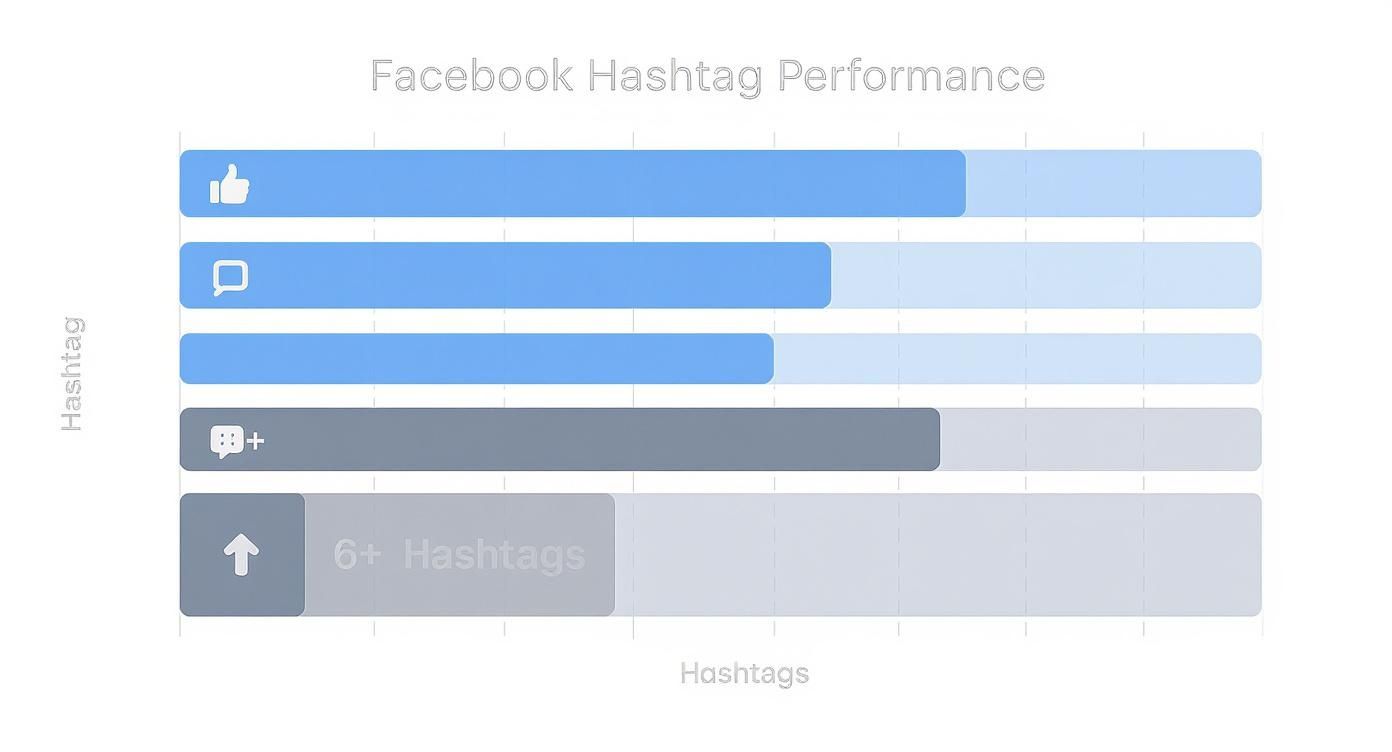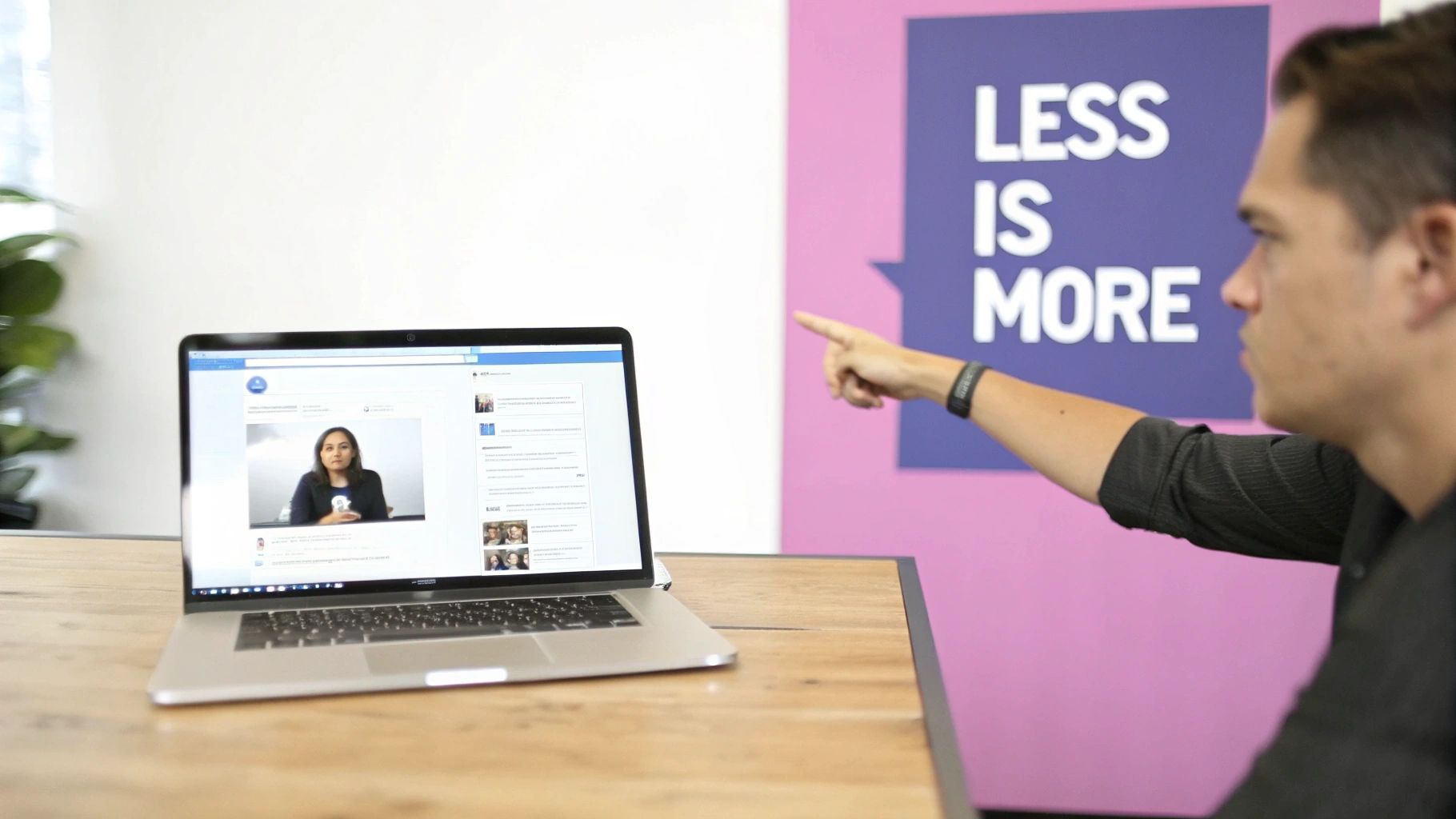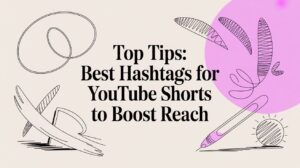If you've spent any time managing social media, you know the golden rule: what works on one platform rarely works on another. This is especially true for Facebook trending hashtags. Trying to copy-paste your Instagram hashtag strategy over to Facebook is one of the fastest ways to kill your engagement. The secret is to stop thinking of them as the same tool—they're entirely different beasts.
Why Hashtags on Facebook Are Different
Ever wonder why that perfectly curated block of 30 hashtags from your latest Instagram post fell completely flat on Facebook? It’s not just you. Facebook's algorithm simply doesn't treat hashtags as a primary discovery tool in the way other platforms do.
Instead of acting like a megaphone to broadcast your content far and wide, a Facebook hashtag works more like a quiet label for a filing cabinet. Its main job is to give the algorithm clues about your content, helping it categorize and surface your post in relevant topic feeds and searches.
People on Facebook just don't scroll through hashtag feeds looking for new content. That’s an Instagram and TikTok behavior. On Facebook, a couple of highly relevant tags are all you need to plug your content into a much larger, ongoing conversation.
The Power of a Minimalist Approach
Let's be honest—a post crammed with a dozen hashtags just looks messy and a bit desperate on Facebook. It disrupts the natural, conversational feel of the platform and can even signal to users (and the algorithm) that your content is spammy.
One single, powerful hashtag often does more work than ten vague ones. It sends a crystal-clear signal about your content's purpose. For instance, a local coffee shop promoting a new blend will see better results with a focused tag like #SupportLocalBusiness than a generic spray of #coffee #coffeelover #latteart #cafe.
This isn't just a feeling; the data backs it up.

As you can see, the sweet spot is clearly one or two hashtags. After that, performance takes a nosedive.
Data-Backed Hashtag Strategy
The "less is more" strategy isn't just an anecdotal best practice—it's written in the numbers. Fresh social media hashtag insights show a stark difference in how Facebook handles hashtags compared to its counterparts.
The data is pretty telling:
- Posts with just one hashtag hit the jackpot, averaging around 593 engagements.
- Jump up to 3-5 hashtags, and that number drops to 416 engagements.
- Go overboard with ten or more, and you're looking at a paltry 188 engagements.
The trend is undeniable. More hashtags lead to less engagement.
Key Takeaway: Stop thinking about volume and start thinking about precision. Your goal on Facebook is to use one or two hyper-relevant hashtags to give the algorithm a clear signpost, directing your content to the people who actually want to see it.
How to Find Relevant Trending Hashtags
Finding the right Facebook hashtags isn't about blindly chasing what's popular or just guessing. It's really about listening to what's going on in your niche and finding the right moment to join the conversation. The real goal is to find tags that are not only buzzing but are also a perfect fit for your content and the audience you’re trying to reach.

Sometimes the simplest tools are the most powerful. Your first stop should always be Facebook’s own search bar. Just type in a keyword that’s central to your industry—say, "sustainable fashion" or "home workout"—and see what hashtags the platform auto-suggests. This is a direct pipeline into what actual users are looking for right now.
Start With Native Facebook Tools
Forget third-party apps for a moment; Facebook itself is your best source of intel. Beyond the basic search, you can get a real sense of the context and volume behind any given tag.
- Explore Topic Feeds: When you click on a hashtag, you land on its topic feed. Think of this as a live, unfiltered stream of all public posts using that tag. Spend some time here. Get a feel for the conversation. Is it full of spam, or are genuine discussions happening?
- Check Hashtag Volume: That same topic feed tells you how many posts are using a specific hashtag. It’s tempting to jump on a tag with millions of posts, but remember that bigger isn't always better. A more focused, mid-sized tag like #MindfulMovement will almost always get you in front of a more engaged fitness audience than a massive, generic one like #Fitness.
Practical Example: Imagine a local café wants to promote a new weekend special. By typing "support local" into the Facebook search bar, they might discover the hashtag #SupportLocalBusiness. A quick click into the feed reveals posts from other shops and happy customers nearby, instantly confirming it's an active, relevant community they should tap into.
This hands-on approach ensures you're joining conversations that already have momentum on the platform.
Monitor Competitors and Industry Leaders
There's no need to reinvent the wheel here. The top voices in your industry, including your direct competitors, are constantly testing hashtags. See what's working for them.
Make a short list of key competitors and influencers you admire. Every so often, scroll through their Facebook pages and look at the hashtags they’re using on their most popular posts. You're not looking to copy-paste their strategy, but to spot patterns and uncover relevant tags you might have otherwise missed.
Practical Example: If you notice several top tech reviewers are all starting to use #TechInnovations on their latest gadget videos, that's a strong signal. It's a timely, relevant tag you could probably use for your own tech content. This method gives you a steady stream of fresh, pre-vetted ideas. While this advice is for Facebook, trends often spill over from other platforms.
Build a Simple Tracking Workflow
To make this all stick, you need a system. A consistent hashtag strategy relies on a simple process for collecting, vetting, and using the tags you discover.
A basic spreadsheet is your best friend here. Create a few columns:
- Hashtag: The tag itself (e.g., #CreativeEntrepreneur).
- Niche: The category it fits into (e.g., Small Business).
- Source: Where you found it (e.g., Competitor X, FB Search).
- Performance: A quick note on how it did when you used it.
This simple tracking sheet turns hashtag research from a chore into a smart, data-backed part of your strategy. Over time, you’ll build a powerful library of what works, helping you consistently get more eyes on your content.
Picking the Right Hashtags for Your Brand
Finding a hashtag that’s blowing up is the easy part. The real work is figuring out if it’s the right one for your brand. A popular tag is totally useless if it puts your content in front of the wrong people or drops you into a conversation that has nothing to do with what you're about. The key is to validate every single hashtag before you commit.

This means you have to do a little homework. Before you slap that hashtag on your next post, click on it. Spend a few minutes scrolling through the feed. What kind of content is showing up? Is the vibe positive and professional, or is it a dumpster fire of spam and negativity? You have to protect your brand, and that means making sure you’re jumping into a constructive discussion.
Analyze Volume and Intent
Hashtag volume is a tricky beast. It’s so tempting to go after the tags with millions of uses, but they’re often way too broad to do you any good. A B2B software company, for example, is going to get much better results from a focused tag like #TechInnovation than a massive, generic one like #trending.
The scale of some of these Facebook hashtags is just staggering. The tag #trending has been used over 875 million times. Meanwhile, you have more niche-specific tags like #technology with 47 million uses and #chatGPT which shot up to 13 million in a blink. These numbers show just how critical it is to match the scale of the hashtag to what you’re trying to achieve. You can dig into more of the data on Facebook hashtag usage on sproutsocial.com.
A high-volume hashtag gets you seen; a high-relevance hashtag gets you seen by the right people. Always prioritize relevance.
Create a Balanced Hashtag Mix
Your best bet isn't to rely on just one kind of hashtag. The smartest strategies use a healthy mix to hit different goals. This approach helps you cast a wide net while also zeroing in on your ideal audience, giving your content the best possible chance to connect.
Try to build a mix that includes:
- Broad-Reach Hashtags: Pick one general (but still relevant) tag like
#DigitalMarketingto tap into a much larger conversation. Think of these as your top-of-funnel awareness builders. - Niche-Specific Hashtags: This is where the magic happens. Tags like
#ContentRepurposingor#SMBmarketingpull in a super-qualified audience that’s already looking for your specific expertise. - Branded Hashtags: Create a unique tag just for your business, like
#YourBrandClips. This is fantastic for building a community, encouraging people to share their own content, and making your campaigns a breeze to track.
This balanced approach is really the foundation of a solid content strategy. For social media content creators trying to build a real community, mastering this mix is what turns fleeting views into loyal followers. When you carefully select hashtags that match your brand’s voice and goals, you stop just chasing trends and start strategically shaping the conversation.
Weaving Hashtags into Your Content Strategy
Finding the right trending hashtags is one thing, but knowing how to use them is what really moves the needle. It's the difference between your content connecting with the right people at the right time or just getting lost in the noise. It’s all about being intentional.
So, where do you put them? A common trick on other platforms is to tuck hashtags into the first comment to keep the caption clean. On Facebook, that's a mistake. The algorithm needs those hashtags right in the post caption to properly index and distribute your content. Don't hide them.
Building Community with Branded Hashtags
Trending hashtags give you a short-term boost, but branded hashtags are what build a lasting community. A branded hashtag is unique to your business—think of it as a digital gathering spot for user-generated content and campaign conversations. It's how you turn passive followers into active participants in your brand's story.
Practical Example: A fitness brand launches a new program. They could create #PeakPerformanceClub and encourage members to share their progress. This generates tons of authentic content and creates a powerful sense of community around their product. A sustainable brand might use a broad tag like #EcoFriendlyLiving to join a larger conversation, but also direct followers to a unique tag for a specific challenge or campaign.
We're seeing a big shift toward this kind of strategy. Marketers are focusing more on niche and branded community hashtags instead of just chasing broad, generic ones. The data backs this up: posts with hashtags tied to specific interests or industries consistently get higher engagement. Facebook's algorithm is rewarding content that fosters genuine community connections. You can see more on how marketers are building sustained engagement on podcastle.ai.
Adapting Your Strategy Across Platforms
If you're like most teams, you're repurposing content across multiple channels. Just remember that a one-size-fits-all hashtag strategy will fail you. The minimalist approach that works wonders on Facebook would be a complete miss on Instagram, where users expect a healthy mix of niche tags. This is especially critical for video, which we dive into in our guide to creating short-form videos for TikTok and Reels.
So, how do you adapt? Here’s a quick look at how you might change your hashtag approach for the exact same tech tutorial video when posting it on different platforms.
Hashtag Strategy for Repurposing Video Content
This table shows how to adapt your hashtag strategy for a single video asset when publishing it across different social media platforms, highlighting the 'less is more' approach for Facebook.
| Platform | Hashtag Approach | Example Hashtags for a Tech Tutorial Video |
|---|---|---|
| Minimal & Precise (1-3 tags). Focus on a single, highly relevant community or topic hashtag to signal context to the algorithm. | #TechInnovations |
|
| Layered & Diverse (8-15 tags). Combine broad, niche, and branded hashtags to maximize discovery in multiple feeds. | #TechTips #GadgetReview #AIforGood #SoftwareTutorial #FutureofTech #TechieLife #Innovation #YourBrandTech |
|
| TikTok | Trend-Focused & Broad (3-5 tags). Mix trending sounds/challenges with relevant, high-volume hashtags to tap into the For You Page. | #TechTok #FYP #GadgetHacks #LearnOnTikTok |
As you can see, Facebook rewards simplicity. The goal isn't to stuff your post with every tag you can think of. It's about picking the one or two hashtags that perfectly define your content and plug it directly into an active, relevant conversation.
Measuring The Impact Of Your Hashtag Strategy

It’s thrilling when a trending hashtag boosts your visibility, but flying blind on data won’t get you far. You need to dig into your Facebook analytics to see which tags actually move the needle. Turning those raw numbers into clear directives is what separates decent campaigns from standout ones.
Rather than chasing likes alone, look for tags that deliver real results. Did your hashtag spark a surge in link clicks or just generate a flurry of quick reactions? Pinpointing these outcomes helps you sharpen your approach with each new post.
Identifying Your Key Performance Metrics
Success means different things for every team. Start by mapping out which measurements tie directly to your objectives. From eyeballs on your content to genuine user interactions, these core indicators show you exactly how your hashtags perform.
Here Are The Metrics I Watch Closely:
- Reach From Hashtags: Number of people who discovered your post via the tags you used.
- Post Engagement Rate: Comments and shares matter more than likes alone.
- Click-Through Rate (CTR): Tracks how many viewers clicked your link after seeing the hashtag.
“Which hashtags led to the most meaningful interactions?” Tracking this keeps you focused on impact, not just impressions.
Practical Example: A small e-commerce shop promoting eco-friendly items with a Facebook Reel tagged #SustainableSwap. After a week, their analytics reveal a 2.5% higher CTR than usual and a noticeable jump in hashtag-driven reach. That’s proof this tag connected them with an audience ready to take action.
Using Analytics Tools For Deeper Insights
Facebook’s native Page Insights gives you a quick look at reach and engagement. It’s great for a single Page but can get messy if you manage several accounts. You’ll find yourself toggling between tabs and copying data into spreadsheets.
That’s where tools like Swiftia really shine. By consolidating your data, they pull all your hashtag metrics into one dashboard, let you filter by date range or campaign, and even automate regular reports for your team. This allows you to spend less time wrangling data and more time planning your next high-impact post.
Answering Your Top Facebook Hashtag Questions
Let's be honest, figuring out Facebook hashtags can feel a bit like guesswork. The advice seems to change all the time, and what works on Instagram can fall flat here. Let's cut through the noise and tackle the questions I hear most often from marketing teams.
How Many Hashtags Should I Actually Use on Facebook?
This is the big one. It’s so tempting to load up a post with every tag you can think of, just in case. But when it comes to Facebook, less is absolutely more.
My rule of thumb? Stick to 1-3 highly relevant hashtags. The data backs this up—posts with just one laser-focused hashtag consistently pull in the best engagement. Once you start adding more, performance tends to drop off. Too many tags can make your post look cluttered or, even worse, spammy to both users and the algorithm. Think of it as sending a clear signal about your content, not just shouting into the void.
Where Do I Put Them? Caption or Comments?
Always, always put your hashtags directly in the post caption.
I see a lot of people tucking them away in the first comment to keep the caption "clean," which is a habit carried over from Instagram. On Facebook, that's a mistake. The algorithm primarily looks at the caption itself to understand, categorize, and serve your content to the right people. Hashtags in the comments are basically invisible to that initial sorting process, which means you're losing a huge chunk of their discovery power.
Practical Example: Imagine a local bakery posts a mouth-watering video of their new sourdough. Adding
#ArtisanBreadright at the end of the caption immediately tells Facebook to show that video to people interested in baking. Hiding it in the comments? It might as well not be there.
Can I Just Copy and Paste My Instagram Hashtags?
Please don't. While it seems like a great time-saver, it's a strategy that usually backfires. The way people use and discover content on these two platforms is worlds apart.
Instagram is built for discovery through a larger set of niche hashtags. On Facebook, that same long string of tags just looks awkward and out of place. It’s a signal that you're not speaking the platform's language, and you'll likely see your engagement suffer for it. You have to tailor your approach for each one.
What's the Difference Between Trending and Branded Hashtags?
Knowing when to use each type is crucial for a smart strategy. They serve two very different purposes.
- Trending Hashtags: Think of these as jumping into a massive, ongoing conversation. They're tied to current events, holidays, or broad cultural topics (like
#AIforGood). Using them is great for a short-term visibility boost and getting your content in front of a wider audience. - Branded Hashtags: These are yours and yours alone. They're custom tags you create for your business, a specific campaign, or for building a community (like
#YourBrandChallenge). They're perfect for organizing user-generated content and creating a unique hub for your fans.
The best facebook trending hashtags strategies don't just pick one or the other. They weave them together, using trending tags to attract new eyes and branded tags to nurture the community you already have.
Ready to turn your long-form videos into a library of high-impact social clips? Swiftia uses AI to help you create stunning, shareable video content up to 10x faster. Try Swiftia for free and start creating today.


